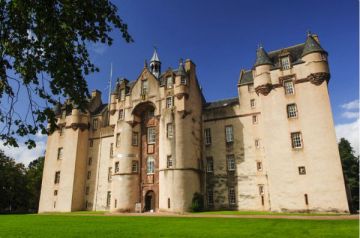The Romans coined the term 'Pict' to describe the tribes of northern Britain. The term means 'painted', but whether it refers to the blue dye used by warriors in battle, or to a form of tattooing, we simply don't know. What little we do know about the Picts comes partly from written Roman records, which must be regarded with a dubious eye, for the Romans never did manage to conquer these 'Picts'.
Pictish carved stones
Our main form of knowledge about them comes from elaborately carved stones they left behind. These Pictish carved stones use common symbols, such as animals, warriors, and mythical creatures as well as geometric patterns such as Z-rods. One theory, not universally accepted by historians, is that the Picts were at least partly matriarchal; that is, kings gained power by marrying a princess, and the royal line passed through the female line. The Picts had more in common culturally with the Irish Celts than with other Scottish tribes.
It would seem that there were actually three main tribes occupying northern Britain between the departure of the Romans and the eventual unification of Scotland in 1034. The far north was the realm of the Picts, while the south was dominated by the Angles of Lothian and the Britons of Strathclyde. This latter group was eventually overwhelmed and absorbed by their Anglian neighbours.
The Scots
Sometime in the late 5th century Irish Celts settled in Argyll. They were called Scotti by the Romans, and the term later became a generic words for inhabitants of Scotland.
The Scotti established the kingdom of Dalriada, with its centre at Dunadd, in Kilmartin Glen, Kintyre. This Scottish kingdom was eventually absorbed by the Picts under Angus MacFerguis, who merged Dalriada and Strathclyde with his Pictish lands. In the south-east, the main tribal kingdom was Bernicia, another Anglian territory.
The Battle of Nectansmere
The northern English kingdom of Northumbria was one of the most powerful kingdoms in the aftermath of the Roman departure. In 671 the Northumbrian king, Ecgfrith, led an invasion north into the territory of the Picts. At Nectansmere, near Dunnichen, Angus, the Northumbrians met the Picts under Brue. If Ecgfrith had triumphed, the united kingdom of Scotland might never have formed, but the Picts pushed back the Northumbrian army. The Picts, Angles, and Scots of Dalriada gained independence from the Northumbrians, and the Picts became the dominate force in Scotland following Nectansmere.
